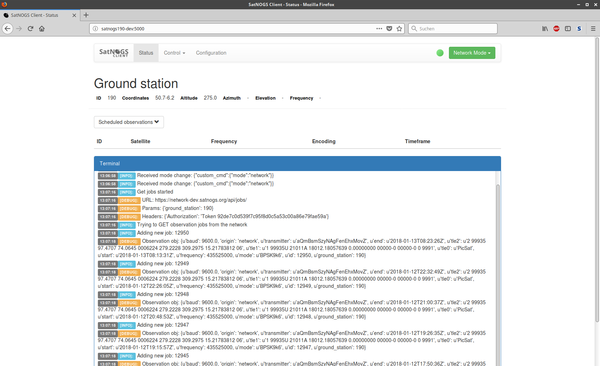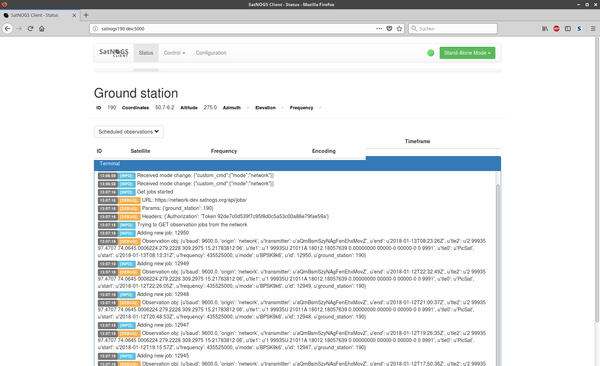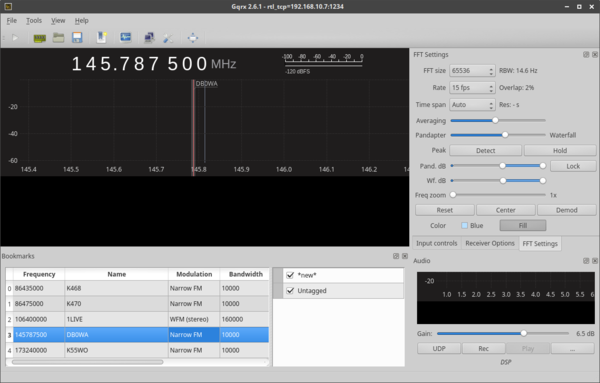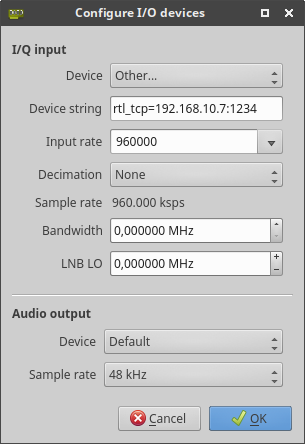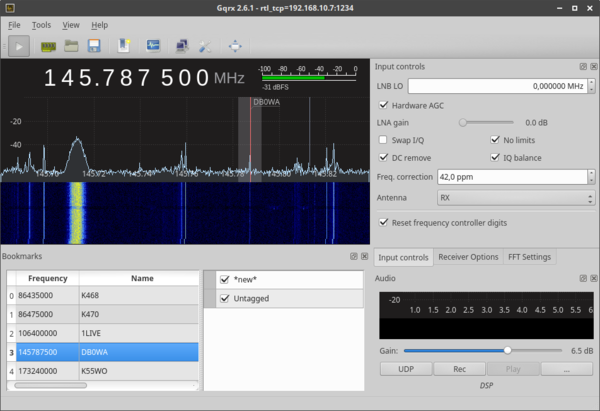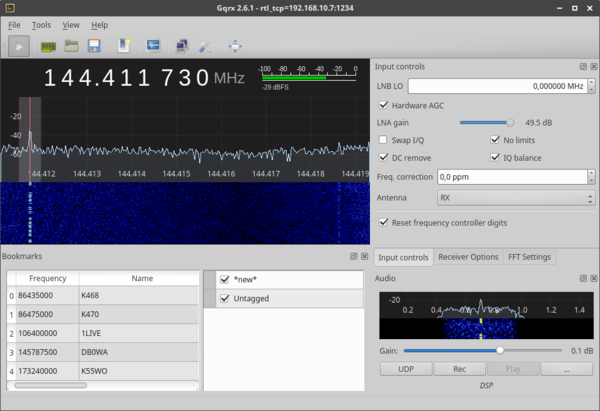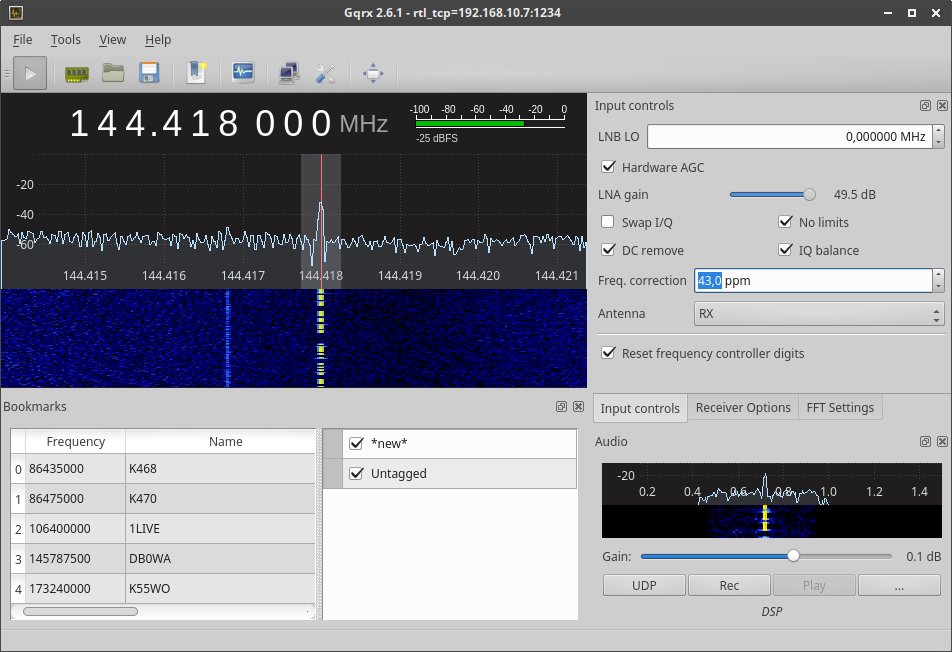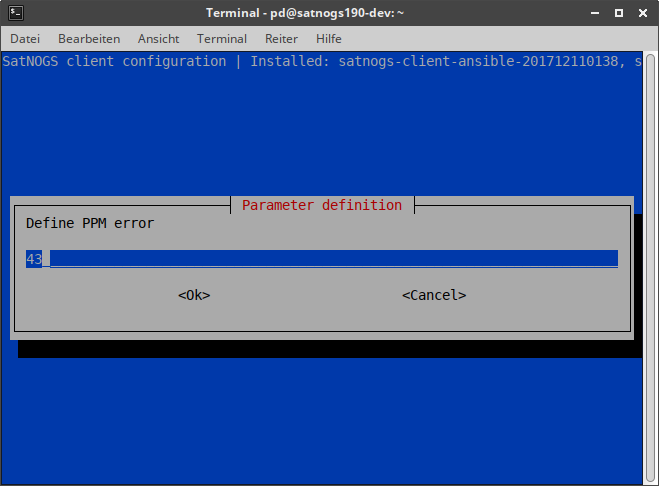Difference between revisions of "Adjusting the SatNOGS Client"
(→automatic adjustment via kalibrate-rtl: Add build instructions for kalibrate-rtl) |
(→SatNOGS station adjustments: Don) |
||
| Line 29: | Line 29: | ||
For usage, see available parameters: | For usage, see available parameters: | ||
| − | + | $ kal -h | |
kalibrate v0.4.1-rtl, Copyright (c) 2010, Joshua Lackey | kalibrate v0.4.1-rtl, Copyright (c) 2010, Joshua Lackey | ||
modified for use with rtl-sdr devices, Copyright (c) 2012, Steve Markgraf | modified for use with rtl-sdr devices, Copyright (c) 2012, Steve Markgraf | ||
| Line 51: | Line 51: | ||
-D enable debug messages | -D enable debug messages | ||
-h help | -h help | ||
| − | + | ||
choose an appropriate band for scanning: | choose an appropriate band for scanning: | ||
| − | + | $ kal -s GSM900 | |
Found 1 device(s): | Found 1 device(s): | ||
0: Generic RTL2832U OEM | 0: Generic RTL2832U OEM | ||
| Line 73: | Line 73: | ||
chan: 86 (952.2MHz - 212Hz) power: 2314696.93 | chan: 86 (952.2MHz - 212Hz) power: 2314696.93 | ||
chan: 116 (958.2MHz - 180Hz) power: 862935.90 | chan: 116 (958.2MHz - 180Hz) power: 862935.90 | ||
| − | + | ||
choose a strong channel: | choose a strong channel: | ||
| − | + | $ kal -c 33 | |
Found 1 device(s): | Found 1 device(s): | ||
0: Generic RTL2832U OEM | 0: Generic RTL2832U OEM | ||
| Line 91: | Line 91: | ||
not found: 0 | not found: 0 | ||
average absolute error: 0.219 ppm | average absolute error: 0.219 ppm | ||
| − | + | ||
Now enter the measured ppm in satnogs-setup and you're done. | Now enter the measured ppm in satnogs-setup and you're done. | ||
Revision as of 08:04, 8 June 2018
(This page is a port of DL4PD's excellent post to the SatNOGS forum.)
Contents
Prerequisites / dependencies
This page assumes:
- you've read all the Getting Started page, as well as the pages linked under "Build" and "Operate" on the Main Page
- you've already made your first observations and have some waterfalls in the Network
- you've installed install gqrx on your local computer.
SatNOGS station adjustments
Now you've come to a point where you want to know how well your station is performing. The first step is to determine your frequency offset.
automatic adjustment via kalibrate-rtl
As a more comfortable way to get the ppm of your SDR the tool kal from https://github.com/viraptor/kalibrate-rtl can be used. At the moment you propably have to get and build it by yourself.
When using the pre-built image for the Raspberry Pi, you have to install the following dependencies:
$ sudo apt-get install libtool pkg-config libfftw3-dev librtlsdr-dev
Then you can build and install it with
$ ./bootstrap $ CXXFLAGS='-W -Wall -O3' ./configure $ make $ sudo make install
For usage, see available parameters:
$ kal -h kalibrate v0.4.1-rtl, Copyright (c) 2010, Joshua Lackey modified for use with rtl-sdr devices, Copyright (c) 2012, Steve Markgraf Usage: GSM Base Station Scan: kal <-s band indicator> [options] Clock Offset Calculation: kal <-f frequency | -c channel> [options] Where options are: -s band to scan (GSM850, GSM-R, GSM900, EGSM, DCS, PCS) -f frequency of nearby GSM base station -c channel of nearby GSM base station -b band indicator (GSM850, GSM-R, GSM900, EGSM, DCS, PCS) -g gain in dB -d rtl-sdr device index -e initial frequency error in ppm -E manual frequency offset in hz -v verbose -D enable debug messages -h help
choose an appropriate band for scanning:
$ kal -s GSM900
Found 1 device(s):
0: Generic RTL2832U OEM
Using device 0: Generic RTL2832U OEM
Found Elonics E4000 tuner
Exact sample rate is: 270833.002142 Hz
kal: Scanning for GSM-900 base stations.
GSM-900:
chan: 33 (941.6MHz - 155Hz) power: 4877018.31
chan: 41 (943.2MHz - 208Hz) power: 2265226.87
chan: 43 (943.6MHz - 133Hz) power: 1287992.91
chan: 55 (946.0MHz - 179Hz) power: 1041611.46
chan: 57 (946.4MHz - 252Hz) power: 1405188.40
chan: 66 (948.2MHz - 13Hz) power: 5027059.56
chan: 79 (950.8MHz - 111Hz) power: 1088677.82
chan: 84 (951.8MHz - 231Hz) power: 945912.38
chan: 86 (952.2MHz - 212Hz) power: 2314696.93
chan: 116 (958.2MHz - 180Hz) power: 862935.90
choose a strong channel:
$ kal -c 33 Found 1 device(s): 0: Generic RTL2832U OEM Using device 0: Generic RTL2832U OEM Found Elonics E4000 tuner Exact sample rate is: 270833.002142 Hz kal: Calculating clock frequency offset. Using GSM-900 channel 33 (941.6MHz) Tuned to 941.600000MHz (reported tuner error: 0Hz) average [min, max] (range, stddev) - 206Hz [-293, -89] (204, 56.913998) overruns: 0 not found: 0 average absolute error: 0.219 ppm
Now enter the measured ppm in satnogs-setup and you're done.
manual adjustment
To start, please connect to your Raspberry Pi's local web interface. By default the URL is something like "http://192.168.0.5:5000"; you'll need to figure out what it is for your client. In the upper right corner there is a big green button where you can set your ground station in standalone mode.
Here's how it looks in network mode:
And here's how it looks when it's switched to standalone mode:
After setting to standalone mode, please SSH to your SatNOGS Pi with your well-known user account; by default, this is the user "pi". After successful authorization you will see a prompt like this:
Linux satnogs190-dev 4.9.59-v7+ #1047 SMP Sun Oct 29 12:19:23 GMT 2017 armv7l The programs included with the Debian GNU/Linux system are free software; the exact distribution terms for each program are described in the individual files in /usr/share/doc/*/copyright. Debian GNU/Linux comes with ABSOLUTELY NO WARRANTY, to the extent permitted by applicable law. Last login: Fri Jan 12 07:34:11 2018 from 192.168.10.35 pd@satnogs190-dev:~ $
Now go ahead and start the "RTL SDR spectrum server":
$ rtl_tcp -a 0.0.0.0
If everything is fine, you will get an output like this:
Found 1 device(s): 0: Generic, RTL2832U, SN: 77771111153705700 Using device 0: Generic RTL2832U Found Rafael Micro R820T tuner [R82XX] PLL not locked! Tuned to 100000000 Hz. listening... Use the device argument 'rtl_tcp=0.0.0.0:1234' in OsmoSDR (gr-osmosdr) source to receive samples in GRC and control rtl_tcp parameters (frequency, gain, ...). No further output will be generated until you connect to this server. Hitting C-c will stop it and the command line appears.
Now go ahead and start gqrx:
You will have to go to the setup menu, either by clicking on the "harde" symbol, or navigating through the menu item called "File -> I/O Devices"
Click on "Device" and chose "RTL-SDR Spectrum Server" Edit "Device string" to match your Pi's IP address, Port defaults to 1234, which is the same as the default setting for your server you just started on the Pi. Set "Input Rate" to something network friendly - we do not need the whole spectrum the RTL SDR is able to convert. 1,8 MSPS (1800000) should be OK Depending on this setting your network will get very busy. Using wireless LAN is not recommended. Every sample has a data size of 16 bits, so the previous setting of 1,8MSPS/s results in a network load of 28,8 MBit/s:
1,8 MSPS * 16 bit/s = 28,8 MBit/s
"Audio Output -> Device" and "-> Sample rate" should be set by default,
values on average soundcards would be something like "Default, 48 kHz"
Close the dialogue by clicking "OK"
Your RTL-SDR spectrum server on the Pi should now show up a connection from
your computer running gqrx.
client accepted! set gain mode 1 set agc mode 0 set direct sampling 0 Disabled direct sampling mode set offset tuning 0 set sample rate 960000 ll+, now 1 ll+, now 2 set freq correction 42 set freq 144500000 set gain mode 0 set agc mode 1 set gain 0 set freq 145814000 ll-, now 0 ll+, now 1 ll+, now 2 ll+, now 3 ll+, now 4 ll+, now 5 ll+, now 6 ll+, now 7 ll+, now 8 ll+, now 9 ll+, now 10 ll+, now 11 ll+, now 12 ll+, now 13
The only thing left now is to "Start DSP" - from the menu item "File", by hitting C-d or simply clicking the Play-Button.
Go for a known local HAM radio repeater or a CW beacon transmitter and set your demodulator accordingly. Narrow Band FM or CW is best to discover ppm error offset, which is the frequency offset in parts per million (ppm) which is always there with standard RTL-SDR dongles. It is also highly temperature dependent, so one might have to re-evaluate this from time to time. Enter the known frequency of your chosen transmitter (NFM repaeter or CW beacon). I have chosen a very known CW beacon just some km away from my home: ON4VHF on 144.718000 MHz. Walk through the tab called "Receiver options" and change the settings to fit the beacon: "Filter width Normal", "Filter shape Normal", "Mode CW-L", "AGC Medium". Set Squelch to something low, so you can hear noise from your speakers. Maybe you have to Adjust the audio "Gain" to something like "0.0 dB". You can adjust this to fit your needs to hear noise. With ppm error, which is default, set to 0.0 ppm, one can just guess where your receiver is listening. Anyway, just set it to 144.718000 MHz and try to find your beacon. You can see the result for my RTL SDR dongle down here:
Now got to the tab called "Input controls" and find an input field called "Freq. correction". By default this should show "0,0 ppm". Set frequency back to your beacons transmit frequency. After this you have to increase the Freq. correction value as long until you can hear the beacon. Now zoom into the panorama by locating your mouse pointer in the range where the frequency values are printed below the panorama, just above the waterfall. Try to fit the Freq. correction value as good as possible, that your receivers red indication line is just in the middle of the transmitters bandwidth.
Now write down the evaluated ppm correction value and exit gqrx as well as the RTL SDR spectrum server. In the command line now available start satnogs-setup:
$ sudo satnogs-setup
Navigate to "Advanced -> SATNOGS_PPM_ERROR" and enter the new value.
Exit the satnogs-setup with "Back", then "Apply Configuration" (this might take a while) and "Back".
You are done with frequency offset correction.
Enhancements
Waterfall color improvements
To get some nicer waterfalls one has to dig into waterfall plotting script. This is a static one and, so far, cannot be configured through satnogs-setup. Anyway: there is no magic behind it and one can understand what the changes are once you have seen them.
Log into the Pi and start at making a copy of /usr/share/satnogs/scripts/satnogs_waterfall.gp, just in case:
$ cp /usr/share/satnogs/scripts/satnogs_waterfall.gp ~/.
Now you can start editing the script:
$ sudo nano /usr/share/satnogs/scripts/satnogs_waterfall.gp
Search for a line starting with cbtics:
# Spectravue palette and scale set cbtics (-110, -105, -100, -95, -90, -85, -80, -75, -70, -65, -60, -55, -50, -55, -40)
Comment it out by adding a #, copy, paste and edit that new line that it matches something like this:
# Spectravue palette and scale #set cbtics (-110, -105, -100, -95, -90, -85, -80, -75, -70, -65, -60, -55, -50, -55, -40) set cbtics (-90, -85, -80, -75, -70, -65, -60, -55, -50, -55, -45, -40, -35, -40, -25)
Now go ahead and find a line with cbrange:
set ylabel 'Time (seconds)' set cbrange [-100:-50]
I guess, one already gets the point - change cbrange to match the new cbtics:
set ylabel 'Time (seconds)' #set cbrange [-100:-50] set cbrange [-85:-35]
Save the file and you are done. Schedule some observations and watch the new colors. Maybe you can just improve it a little more but keep in mind: always keep a bit of the noise floor into the waterfalls, so you can see the whole signals dynamic range. I love it, when there are only a few dots of the noise.
